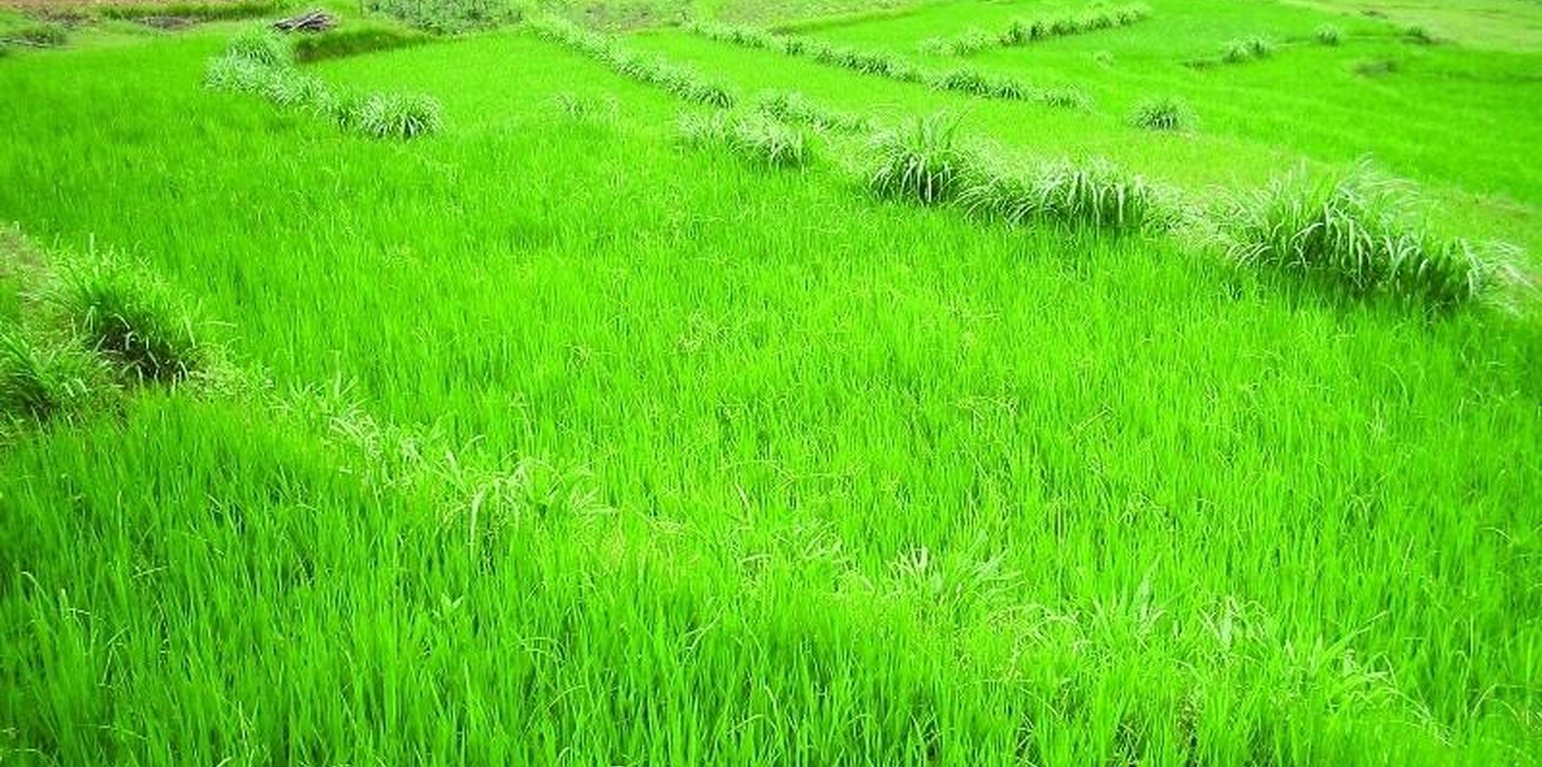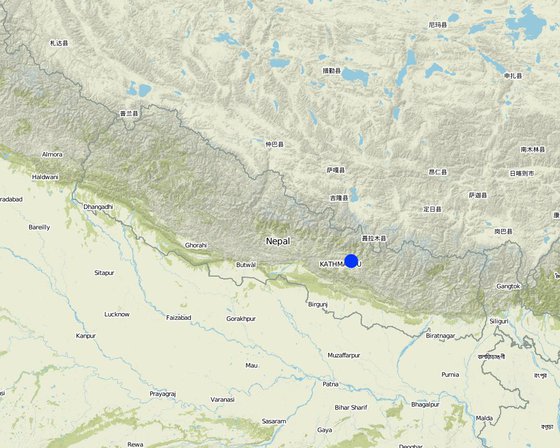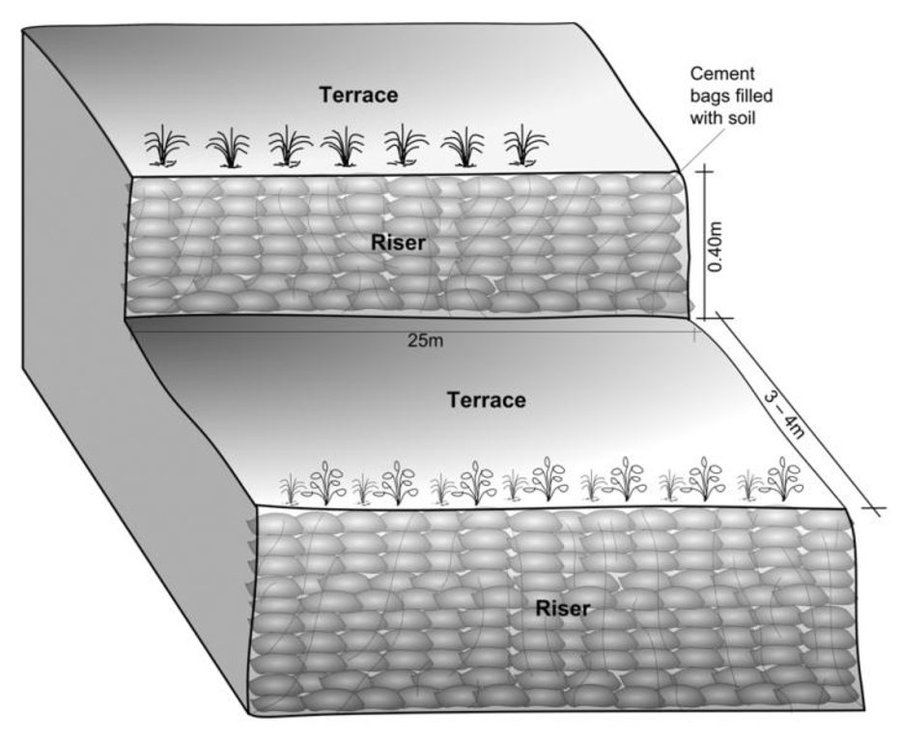



This technology addresses the soil erosion and water runoff problems associated with traditional outward-sloping terraces by reshaping the land into a series of level or gently sloping platforms across the slope. This technology is a variant of sloping land agricultural technology (SALT) or contour hedgerow technology. Nitrogen-fixing hedgerow species and quality fodder grass species, which bind the soil, are cultivated along terrace riser margins to improve terrace stability. This also enhances soil fertility and increases fodder availability. The plants are grown in either single or multiple layers. The practice is applied under rainfed conditions and is culturally acceptable and affordable. After establishment, the technology also addresses the problems of fodder scarcity making it easier and less time consuming for women and girls to gather fodder.
The hedgerow and grass species are established between January and June. Complete establishment of this technology may take one year. The first step in creating the terraces is to build retaining walls using cement bags filled with soil which are then supported with bamboo cuttings along the contour (= future terrace risers). This divides the land into the planned terrace sections. The length and width of the terraces depends on the size and shape of the original field. Secondly, the soil is excavated from the upper part of the terraces and is used to build up the lower part above and behind the terrace riser wall to create a level bed. The fertile top soil must be kept aside and later spread over the newly terraced fields. The final step is to plant grass and hedgerow species on the outermost margins of the terrace above the risers.
Maintenance involves slicing the terrace risers once or twice a year with a spade, and smoothing off rills that appear on the surface of terraces after the premonsoon and monsoon periods. Hedgerows should be cut regularly but not more than twice a year, normally to a height of about 50 cm. Grasses should be cut about once to twice a month depending on their rate of growth.
The technology is applied under humid subtropical climate conditions (1300 mm annual rainfall with about 80% of it falling in the monsoon months of June - September). The case study area has hill slopes of 16-30% that are mostly highly erodible red soils (FAO classification: luvisols).

地点: Hokse VDC ward no2, 尼泊尔
分析的技术场所数量:
技术传播: 均匀地分布在一个区域 (0.0126 km²)
在永久保护区?:
实施日期: 50多年前(传统)
介绍类型






| 对投入进行具体说明 | 单位 | 数量 | 单位成本 (美元) | 每项投入的总成本 (美元) | 土地使用者承担的成本% |
| 劳动力 | |||||
| Labour | ha | 1.0 | 970.0 | 970.0 | 50.0 |
| 设备 | |||||
| Total costs | ha | 1.0 | 92.0 | 92.0 | 100.0 |
| 植物材料 | |||||
| Seeds | ha | 1.0 | 25.0 | 25.0 | |
| Seedlings | ha | 1.0 | 30.0 | 30.0 | |
| Bamboo | culms | 80.0 | 1.0 | 80.0 | 50.0 |
| 施工材料 | |||||
| Cement bags | ha | 1.0 | 80.0 | 80.0 | 50.0 |
| 其它 | |||||
| Supervision charge | ha | 1.0 | 10.5 | 10.5 | |
| 技术建立所需总成本 | 1'287.5 | ||||
| 技术建立总成本,美元 | -1'287.5 | ||||
| 对投入进行具体说明 | 单位 | 数量 | 单位成本 (美元) | 每项投入的总成本 (美元) | 土地使用者承担的成本% |
| 劳动力 | |||||
| Labour | ha | 1.0 | 310.0 | 310.0 | 100.0 |
| 设备 | |||||
| Tools total costs | ha | 1.0 | 20.0 | 20.0 | 100.0 |
| 植物材料 | |||||
| Seeds | ha | 1.0 | 6.0 | 6.0 | 100.0 |
| Seedlings | ha | 1.0 | 6.0 | 6.0 | 100.0 |
| 技术维护所需总成本 | 342.0 | ||||
| 技术维护总成本,美元 | -342.0 | ||||
maize crop by 100%
households of neighbouring village benefitted.
by >100% due to higher
terrace improvement group was formed
Cropping pattern changed due to which, land users were able to produce more. Farm income and price of land increased.
nearby hedgerows
along risers
due to levelled surface and hedgerow barrier
Bigger area needs swc measures
through farmer to farmer dissemination
due to reduced nutrients leaching on-site